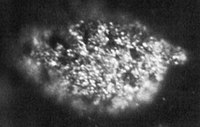
Photo from wikipedia
INTRODUCTION Nowadays ever smaller, sub-centimetre lung nodules are screened and diagnosed. For these, minimally invasive resection is strongly recommended both with diagnostic and therapeutic purpose. AIM Despite many advantages of… Click to show full abstract
INTRODUCTION Nowadays ever smaller, sub-centimetre lung nodules are screened and diagnosed. For these, minimally invasive resection is strongly recommended both with diagnostic and therapeutic purpose. AIM Despite many advantages of minimally invasive thoracic surgery, thorough palpation of the lung lobes and thus the localization of lung nodules are still limited. There are several options to solve this problem. From the possibilities we have chosen and tried wire- and isotope-guided lung nodule localization. MATERIALS AND METHODS In 2017, at the Thoracic Surgery Department of the National Institute of Oncology we performed wire- and isotope-guided minimally invasive pulmonary nodule resection in five patients. The diameter of the lung nodules was between 0.5 and 1.2 cm. The age of the patients was between 44 and 65 years and none of them had severe comorbidities, which meant low risk for complications. RESULTS We successfully performed the minimally invasive atypical resection in all cases. After the wire and isotope placement we found a 2-3 mm pneumothorax in one patient that did not need urgent drainage. In another patient we found that high amount of intraparenchymal bleeding surrounded the channel of the wire. During the operation, two wires were displaced when the lung collapsed, and in another case the mentioned bleeding got into the thoracic cavity and made it difficult to detect the nodule. In one case we resected the wire-guided lung tissue, but the isotope-guided lung nodule was below the resection line. CONCLUSION Both techniques could help to localize the non-palpable lung nodules. Based on our initial experiences, the isotope-guided method provides more details to estimate the exact depth of the nodule from the visceral surface of the pleura and we can avoid the unpleasantness of wire displacement. On the other hand, the production of the isotope requires a more developed infrastructure and the exact timing of the operation after the isotope injection is more strict. Orv Hetil. 2018; 159(34): 1399-1404.
Journal Title: Orvosi hetilap
Year Published: 2018
Link to full text (if available)
Share on Social Media: Sign Up to like & get
recommendations!